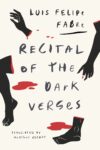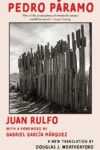This essay first appeared in the Full Stop Quarterly, Issue #7. To help us continue to pay our writers, please consider subscribing.
Yuri Herrera is one of a new group of writers who are products of the cultural hybridity between the U.S. and Latin America, whose lives and literature are transnational, blurring the hard lines of political and linguistic borders, even pointing to a world where such borders are irrelevant. His peers include Francisco Goldman, US-born who splits his time in Mexico City; Daniel Alarcón, a Peruvian American who writes fiction in English inspired by recent Latin American history; and Valeria Luiselli, raised in Mexico and based in New York, writing in two languages about two countries. Herrera, one of the most exciting novelists I know of in any language, comes from Mexico and writes in Spanish, but studied in El Paso and Berkeley, and is now based in New Orleans, where he teaches at Tulane. Among these authors, he stands out as a singular voice of the border, mining its paradoxes and its language while refusing its clichés. At a time when the US-Mexico border has catapulted from a slow-motion crisis to a political inferno, it’s critical to open our ears and aim them in the right direction.
This year, the last of three novels by Yuri Herrera was published in English, forming a thematic trilogy on the border. All three were translated by Lisa Dillman, whose close collaboration with Herrera has yielded incredibly successful results from a writer initially thought by a publisher to be untranslatable. Though Herrera’s a political scientist by training, he does not write didactic fiction, nor does his work overwhelm you with the pain and suffering that is very real in the border region. Rather, these three short novels — Kingdom Cons, the tale of a writer of ballads in the court of a narcotrafficker; Signs Preceding the End of the World, a vivid, mythic dream of border-crossing in search of missing family; and The Transmigration of Bodies, a fast-paced noir about a broker of underworld transactions in a plague-stricken town of feuding crime families — each in a different way work to humanize and bring into intimate focus the complexities and challenges of the border.
Herrera’s books are short, his style compact, yet his subjects are expansive; like the desert, they’re rich with space and silence. While his work is approachable, it’s not without challenges to the reader: cryptic, elliptical language, choice vaguenesses that force a reading between the lines. His prose can read like the stylized minimalism of early Denis Johnson or Raymond Carver, crossing gritty quotidian detail with the unexpected to produce a very naturalistic sense of the surreal. But at times he more resembles another gringo Raymond: Chandler, the proponent of paranoid, densely-plotted noir. And at turns, Italo Calvino or Jorge Luis Borges, with terse but suggestive language that hints at the mysterious and the timeless. Herrera is something of a postmodernist, though in content more than style: he said in an interview in Queen Mobs Tea House earlier this year that “Foucault can show you a lens to view society and power, but will not teach you how to write a good story.”
If Herrera’s mythological flirtations — Signs Preceding the End of the World is loosely based on Aztec myth — and flashes of the surreal edge on a kind of magical realism, it’s if anything a return to the roots of the style, which originated with Juan Rulfo, to whom Herrera has often been compared. Rulfo, like Herrera, was a Mexican who placed his work in the arid lands of the country’s North; his classic Pedro Paramo (1955), which Garcia Marquez committed long passages of to memory, pioneered the flat psychological realism which rendered “magical” elements like spirits with the same weight it did its physical characters, without being a genre-bound tale of the supernatural. But Herrera’s world is closer to the urban sensibility of contemporary Horacio Castellanos Moya, who said in 2009 of his generation of Latin American writers, “our reality has not been magical,” evoking a lived experience closer to Los Angeles than Macondo (the village of One Thousand Years of Solitude).
Herrera’s variation on Rulfo’s gestures against the confines of literary realism is to fearlessly incorporate elements of genre fiction and popular art into his novels, with a dryness of style and freshness of perspective that pulls off these risky moves and makes it look easy. In Kingdom Cons it’s the corrido, the Western, the fairytale. In The Transmigration of Bodies, the hard-boiled crime novel. In Signs Preceding the End of the World, ancient Aztec mythology. In a nod to this heterodoxy of influence, Herrera said in an interview with Roy Kesey from this year:
When we speak about our influences, we are speaking mostly about our desires and our pretensions. It’s like I’m saying ‘yea, I was thinking about Quevedo,’ but I have also learned about the Simpsons. And that’s ok . . . I think of the figure of the painter who has a palette with different colors, who has to mix them in order to figure out what tones he is going to use. And for me, this palette includes Quevedo, and (Daniel) Sada, and Rulfo — but it also includes the people saying things on Twitter.
Herrera’s ability to draw new life from bitter subjects and timeworn genres may also have something to do with his time in the arid reaches of his native state of Hidalgo — as well as his time in Texas and Chihuahua. He claimed in a 2015 interview that “one of my first tasks, when I started writing seriously, was to find a beauty in dry, hot, deserted areas, in this absence of exuberance.”
*
There’s a strong case that Kingdom Cons — published originally in 2004 as Trabajos del Reino and written when the author was living in El Paso and Ciudad Juarez — is one of the best books to be published in English in 2017. The form of the novel as a reflection of its subject matter is rarely so perfectly achieved. Kingdom Cons has the timeless feel of a folktale, but one that consciously exhumes the uncomfortable truths about power buried beneath those stories of kings and queens: the feudal social relationship between the king and his vassals, the arbitrary nature of worldly power. The merger of modern realities and ancient forms of storytelling in the book is a mirror of the narcocorrido phenomenon it depicts, in which successful narcotraffickers will commission songs to be written about themselves and their exploits, not unlike murderous Medici hiring Rennaissance painters to do their portraits — in a songwriting form (the corrido, a narrative ballad) that is itself centuries old.
Lobo, the songwriter protagonist of Kingdom Cons is saved from desperate poverty and folded into the glorious and grotesque happenings of the narco King’s court, where he becomes known as the Artist, joining a cast of courtesans known only by their job or social role: the Jeweler, the Journalist, the Witch, the Commoner. These names are also masks that hide their opposite. The Journalist is in charge of twisting the news, doing PR for the King. The Commoner turns out to be anything but common. And the Artist — like the Journalist — is safe so long as he serves only as a propagandist.
The fable that Kingdom Cons ends up spinning is one that resonates across ages and societies. The artist is never free of patronage, which is perennially in tension with authenticity. And yet, that possibility is always there: the artist can always reach for that “constant light” — as the inspiration of words is called in a luminous passage of the book — and become an ungrateful servant, the dog that bites the master’s hand, by following their own intuition instead of the parameters of fealty. Herrera’s concern with the multifaceted history of the corrido, which he has pointed out in more than one interview, unfolds over the course of the story: the genre has long taken aim at the powerful as well as served to lionize them.
Kingdom Cons achieves a curious effect only possible in a novel: the feeling of a rich ambiguity — and I would argue this is one of Herrera’s signature talents. Like a double exposure, two film reels superimposed and transparent, which the language layers. Courtiers and palaces flip back to guns and accordions — and so ebbs and flows the mood and imagery of the ancient and the modern. In addition to its style and compact grace, the novel is simply a damn good read: gripping and entertaining, begging to be read in a single sitting. Herrera’s command of storytelling is evident in the keep-you-guessing clues leading up to reveal of the King’s hidden weakness; set pieces like the Artist’s crafty maneuver during a shooting contest that lets the King save face; and the economy of detail that ensures every peacock, stack of books or electric fence both paints the world and moves the narrative forward. The reader is both surprised and satisfied with a story that feels, at every turn, inevitable but not predictable.
*
Kingdom Cons arrives in English translation at a moment when stories about the drug traffic are almost omnipresent, on both sides of the border. The narco-themed or commissioned corrido has slowly become more familiar in the Anglophone north — which makes sense; the subgenre itself is strongly rooted in Mexico, but transnational like the drug trade it documents, with roots in California as well as Sinaloa. Angeleno journalist Sam Quinones reported on the phenomenon in a profile of Chalino Sanchez — the Hank Williams of the genre — in 2001’s True Tales From Another Mexico. Musician and author Elijah Wald expanded on this the following year with a book called simply Narcocorrido documenting key songwriters. William T. Vollman devoted a lengthy passage of his tome on the US-Mexico border, Imperial (2009), to the form.
In pop culture, the subgenre was introduced to many through Breaking Bad (2008-2013) which featured a corrido the show had commissioned from Los Cuates del Norte. While some years ago Mexican pop culture had gripping “narconovelas” like the smash hit La Reina del Sur (2011), north of the border we’ve been catching up with Netflix’s successful Narcos series (begun in 2015, modeled on the 2012 Columbian drama about Pablo Escobar, El Patrón del Mal), not to mention the English language remake of La Reina del Sur, which debuted in 2016.
This chronology is not only to point out that the publication of Kingdom Cons in English is timely, but also that its 2004 publication in Spanish seems if not trendsetting, at least early in the curve of a cultural and media phenomenon. This did not go unnoticed. In fact, early on Herrera was called prescient: “The following year,” after the Spanish-language publication of the book, Herrera said, “several singers were killed because they were singing against someone, or praising someone — and some people started paying attention to the book as if I’d anticipated this. And what I say is that it’s not that I had anticipated this, it’s just that I was paying attention to a certain part of reality.”
This pattern continued as Herrera’s subsequent two novels (which made it into translation first) reflected the rising tensions, and even apocalyptic mood, in the United States with the border as one of its central anxieties — and garnered attention and space on bookshelves as a result. The world described by the three novels of this thematic border trilogy is a present that despite — or because — of its hints of the archaic, has the ring of a dystopian near-future. Some of this is due to Herrera’s close attention to inequality: in an age of widening gaps between global haves and have-nots, billionaire demagogues and displaced populations, the revival of feudal social relations so vividly drawn in Kingdom Cons that is already in place in pockets of our modern world has the chilling air of a warning.
Because the figure of the narco is not the only modern Lord running the clock backwards against democracy — he’s just the most transparent. Herrera pointed out the universality of the “narco aesthetic” in an interview this year: “it’s something you can see in Fifth Avenue in New York; it’s something you can see courts in France and in Spain.” And with a hint dropped at “named on buildings” he gave a nod to the obvious: this is the very same aesthetic flaunted — and sold — by Donald Trump.
In regards to the role of literary art in our politics, Herrera has said that “I don’t have the expectation that novels will change a political situation.” But he added: “What I always say is, novels are not responsible for creating good or bad men or women, but are a tool for creating more conscious and critical citizens.” To this end, the US, Mexico, and the world at large is lucky to have Yuri Herrera’s voice.
Justin Allen was born in Bakersfield in 1979 and raised in Northern California, earned a BA in English at San Francisco State University, and has worked as an editor, designer, and technologist for arts, activist, and news organizations. Justin’s short fiction has been published in Catamaran, Crannóg, Fiddleblack, and Transfer. Justin’s journalistic work has appeared in the Sacramento News & Review, the San Francisco Public Press, EdSource, and other publications.
This post may contain affiliate links.








